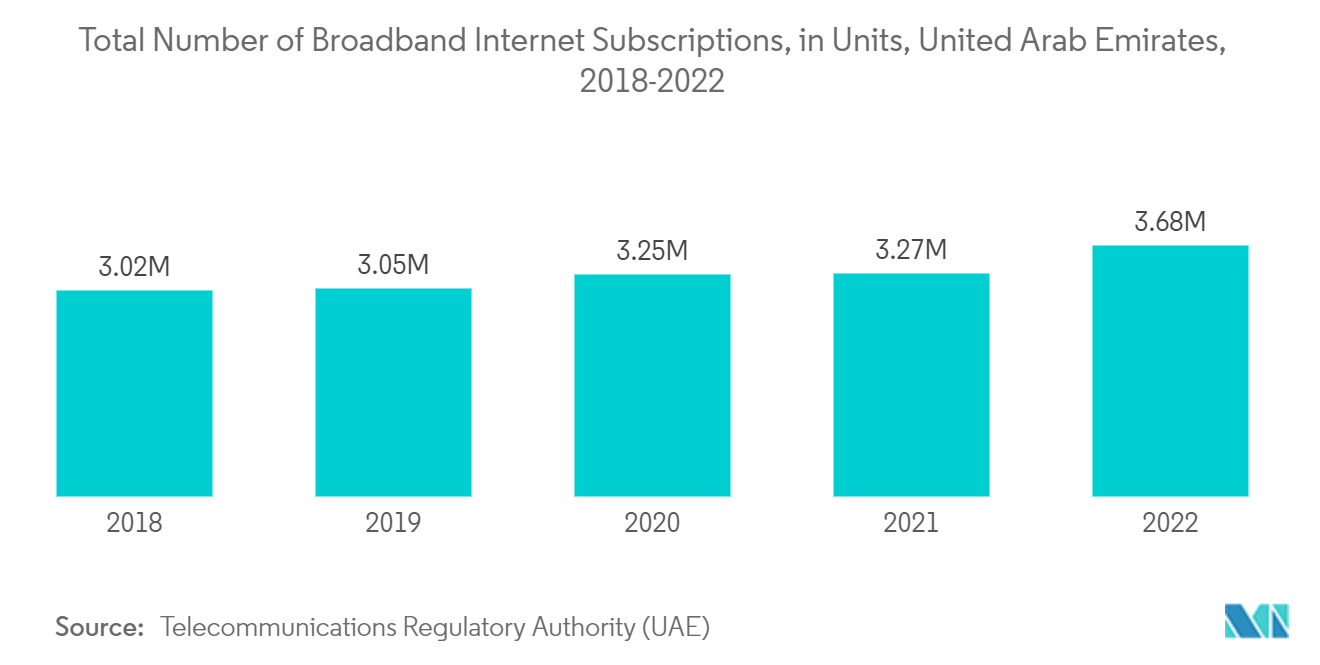Market Trends of Middle East Data Center Storage Industry
IT and Telecom to Hold Significant Share
- The market is characterized by a shift toward software-defined infrastructure, enhancing scalability and agility. As the demand for seamless connectivity rises, telecom companies are poised for sustained expansion in storage equipment.
- The rollout of 5G networks is expected to strengthen the digital economy and increase demand for data center storage infrastructure. The arrival of 5G is expected to bring a major increase in speeds, low latencies, and an unforeseen level of network capabilities. This will set the stage for even more advanced and novel applications, enabling everything to be more connected in real-time.
- Telecom suppliers are encouraged to invest in the data center business by quickly rising 4G adoption and the impending 5G wave. In the United Arab Emirates, there were about 18.7 million active mobile phone subscribers as of March 2022, according to the UAE Telecommunications Regulatory Authority. This figure shows a slight rise from December 2020.
- According to an Ericsson Mobility 2020 estimate, there are likely to be 80 million 5G customers in MENA by 2025. This widespread use benefits companies and other technological advancements in the region and lays the groundwork for smart cities and worldwide communication. Furthermore, the telecom authority in the United Arab Emirates set an ambitious objective of 100% 5G penetration in the country by 2025 in order to become the Middle East's technically prominent player in the networking system.
- 5G is close to seven times better in terms of throughput compared to 4G, at 10 Gbs compared to 1.45 Gbs. With NVMe or SSD over HDD, such enterprise-level technology allows significant I/O throughput. The demand for NVMe is expected to increase in SSD servers and storage appliances, which is expected to drive the market during the forecast period.

Saudi Arabia to Witness Significant Growth
- The growth in data generated by the enterprise, coupled with the growing adoption of cloud technology, is expected to drive market studied in Saudi Arabia. Rapid cloud-based technology adoption is projected to help accelerate the country's digital transition while protecting mountains of data.
- With enticing investments from cloud providers such as Google and Oracle, the data center business has started to pick up steam. For instance, Oracle will work with NEOM Tech & Digital Holding Co. as the first tenant in the hyperscale data center at NEOM to serve Saudi Vision 2030. The data center will house Oracle Cloud Infrastructure (OCI), which would offer a high-performing, resilient platform for cloud services.
- The Saudi government has recognized the demand and accordingly outlined AI as a pillar of Vision 2030. This is part of the country’s strategy to evolve into a knowledge-based society, diversify its oil-based economy, and become a global hub for technological development.
- Around 70% of Vision 2030 strategic goals are closely related to AI. To achieve its mission, Saudi Arabia has led a concerted effort to advance its technological capabilities and to create a domestic AI-enabled digital ecosystem by 2030. The National Strategy for Data and Artificial Intelligence (NSDAI) will seek to attract USD 20 billion in foreign and local investments by 2030.
- Under Saudi Vision 2030, foreign investment is encouraged, particularly in the technology sector. The implementation of the cloud-first strategy in 2019 also accelerated the uptake of innovative technologies such as AI for Industrial 4.0. The Cloud Computing Regulatory Framework, which was adopted by the Communications and Technology Information Commission, intends to improve cloud computing services in the country and promote regulatory openness. Overall, it is expected that with an increase in big data volume through AI and other technology, the demand for data center construction will increase, leading to the major adoption of storage equipment.


